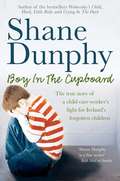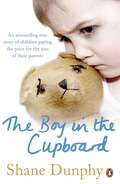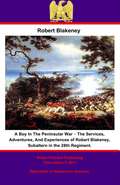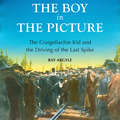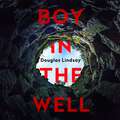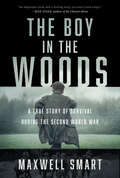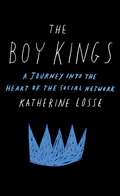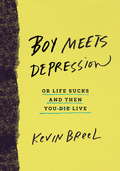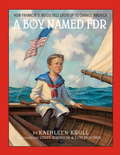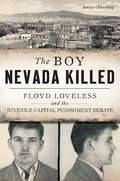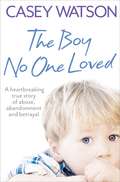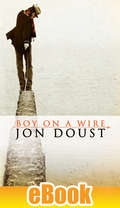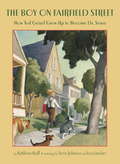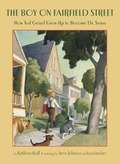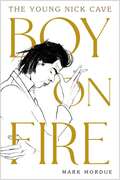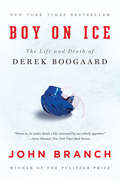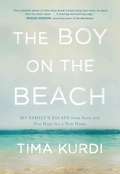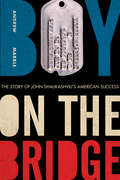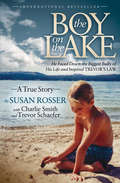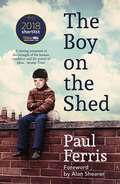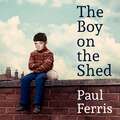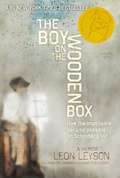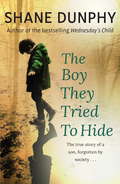- Table View
- List View
Boy in the Cupboard
by Shane DunphyPetru and Elvira Tomescu and their young son, Litovoi, are a Romanian family, desperate to start afresh in a new country. Yet their past has already caught up with them, and three-year-old Litovoi is about to pay a terrible price ...
The Boy in the Cupboard
by Shane DunphyThree heart-stopping stories of children trapped by their parents' pasts ... Craig, the little boy who can't speak English, isn't allowed to use his real name and hides food around his playschool, afraid he'll be hungry again. His parents are trying to make a fresh start, but their gangland bosses are about to catch up with the family and Craig will pay a terrible price...Edgar is a twelve-year-old boy who nobody wants, not even the staff at the residential unit where he lives. Just when it seems that there might be a way of getting through to Edgar, his mother reveals a secret that changes everything ...Vinnie is a teenage boy who knows exactly what his gangster father is capable of, of how he makes problems disappear. He also knows that he had become a very big problem for his father ...... One man's fight to give these children the future they deserve.
A Boy In The Peninsular War – The Services, Adventures, And Experiences of Robert Blakeney, Subaltern in the 28th Regiment.: The Services, Adventures And Experiences Of Robert Blakeney, Subaltern In The 28th Regiment
by Julian Sturgis Robert BlakeneyThis ebook is purpose built and is proof-read and re-type set from the original to provide an outstanding experience of reflowing text for an ebook reader. Robert Blakeney was by modern standards a callow youth at the age of fifteen, in the standards of the time in which he lived he was a gentleman and a soldier. Blakeney was commissioned as a subaltern in the 28th Regiment, he was to see tough and trying service in the Peninsular under both Sir John Moore and the Duke of Wellington. Although the author eschews any literary pretensions, claiming that he was far too busy with his active career soldiering, the autobiography is excellently written with no little wit, aided no doubt by tight editing by Julian Sturgis. His description of the hell of Badajoz is particularly well done. Many incidents of the camp and bivouac that Blakeney recounts revolve around the characters of his soldiers, who not infrequently happen to be Irish, and the great generals that he meets in carrying out his duties; such as Sir John Moore, Lord Paget, General Graham and the Iron Duke himself. As an example of which Lord Paget is memorably recalled infusing some urgency into one of Blakeney's superiors during the retreat of 1809; 'Dragoon, what news?" "News, sir? The only news I have for you is that unless you step out like soldiers, and don't wait to pick your steps like bucks in Bond Street of a Sunday with shoes and silk stockings, damn it! you'll be all taken prisoners." "Pray, who the devil are you?" came from the cart. "I am Lord Paget," said the dragoon;' Blakeney, served during the Copenhagen expedition, the Coruña campaign including the battle, the siege of Tarifa, the battle of Barossa, the siege of Badajoz, and finally the battle of Nivelle in which he is severely wounded. A highly enjoyable and recommended read. Text taken, whole and complete, from the 1899 edition, published in London, John Murray. Original -369 pages Author - Robert Blakeney - (1789-1858) Editor - Julian Sturgis - (1848-1904) Map - Not included due to its size Linked TOC.
The Boy in the Picture: The Craigellachie Kid and the Driving of the Last Spike
by Ray ArgyleEdward Mallandaine was there! To prove it he thrust himself into the historic photograph of the "Last Spike" being driven to mark the completion of the Canadian Pacific Railway. Surrounded by the railway dignitaries of the time, his young face peers out amid their frosty beards. Edward had just turned eighteen when he left his home in Victoria, British Columbia, to join the Canadian militia to fight Louis Riel in the North-West Rebellion of 1885. Hired to ride dispatches over the unfinished stretch of railway in British Columbia, he meets highway men, high officials, men of the North-West Mounted Police, and the denizens of saloons hidden away in mountain passes. He survives the lawlessness of remote towns and railway camps, rubs shoulders with Chinese labourers struggling to blast a right-of-way through the towering peaks of Eagle Pass, and makes a freezing midnight ride by railway flatcar to reach the outpost of Craigellachie just in time.
Boy in the Well: A Scottish murder mystery with a twist you won't see coming (DI Westphall 2) (DI Westphall #2)
by Douglas LindsayBook 2 in the DI Westphall series.'The Boy in the Well is a dark and satisfying mystery. I thoroughly enjoyed my time in the company of DI Ben Westphall, a compelling personality . . . This one comes thoroughly recommended' James OswaldThe body of a young boy is discovered at the bottom of a well that has been sealed for two hundred years.Yet the corpse is only days old . . .Soon, similarities from an old crime emerge and DI Ben Westphall must look to the past to piece together the dark and twisted events taking place in the present.(P)2019 Hodder & Stoughton Limited
The Boy in the Woods: A True Story of Survival During the Second World War
by Maxwell SmartThe astonishing true story of a boy who survived the war by hiding in the Polish forest Maxwell Smart was eleven years old when his entire family was killed before his eyes. He might have died along with them, but his mother selflessly ordered him to save himself. Alone in the forest, he dug a hole in the ground for shelter and foraged for food in farmers’ fields. His clothes in rags and close to starvation, he repeatedly escaped death at the hands of Nazis.After months alone, Maxwell encountered a boy wandering in the forest looking for food. Janek was also alone; like Maxwell he had just become an orphan, and the two quickly became friends. They built a bunker in the ground to survive through the winter. One day, after a massacre took place nearby, the boys discovered a baby girl, still alive, lying in the arms of her dead mother. Maxwell and Janek rescued the baby, but this act came at a great cost. Max’s epic tale of heroism will inspire with its proof of the enduring human spirit. From the brutality of war emerges a man who would become a celebrated artist, offering the world, in contrast to the horrors of his suffering, beautiful works of art. The Boy in the Woods is a remarkable historical document about a time that should never be forgotten.
The Boy Kings: A Journey into the Heart of the Social Network
by Katherine LosseKate Losse was a grad school refugee when she joined Facebook as employee #51 in 2005. Hired to answer user questions such as "What is a poke?" and "Why can't I access my ex-girlfriend's profile?" her early days at the company were characterized by a sense of camaraderie, promise, and ambition: Here was a group of scrappy young upstarts on a mission to rock Silicon Valley and change the world. Over time, this sense of mission became so intense that working for Facebook felt like more than just a job; it implied a wholehearted dedication to "the cause." Employees were incentivized to live within one mile of the office, summers were spent carousing at the company pool house, and female employees were told to wear T-shirts with founder Mark Zuckerberg's profile picture on his birthday. Losse started to wonder what this new medium meant for real-life relationships: Would Facebook improve our social interactions? Or would we all just adapt our behavior to the habits and rules of these brilliant but socially awkward Internet savants who have become today's youngest power players? Increasingly skeptical, Losse graduated from customer service to the internationalization team--tasked with rolling out Facebook to the rest of the world-- finally landing a seat right outside Zuckerberg's office as his personal ghostwriter, the voice of the boy king. This book takes us for the first time into the heart of this fast-growing information empire, inviting us to high-level meetings with Zuckerberg; lifting the veil on long nights of relentless hacking and trolling; taking us behind the scenes of raucous company parties; and introducing us to the personalities, values, and secret ambitions of the floppy-haired boy wonders who are redefining the way we live, love, and work. By revealing here what's really driving both the business and the culture of the social network, Losse answers the biggest question of all: What kind of world is Facebook trying to build, and is it the world we want to live in? *** "Logging on to Facebook that first day, in retrospect, was the second, and to date the last, time that any technology has captured my imagination. The first was when Apple advertised the first laptop, the PowerBook, in the 1990s--with the words, 'What's on your PowerBook?' "'World domination,' my teenaged self- answered instinctively. That's what these devices were made for, I thought: so small and yet so powerful, so capable of linking quickly to and between everything else in the world. From the laptop, I could write and distribute information faster than ever before. It was intoxicating to imagine, and Facebook's sudden, faithful rendering in 2004 of the physical world into the virtual felt the same. What could you do, now that you could see and connect to everyone and everything, instantly? "But what, also, could be diminished by such quick access? In the realm of ideas, it seemed easy: Who wouldn't want to distribute and discuss ideas widely? However, in the realm of the personal, it seemed more complicated. What was the benefit of doing everything in public? Is information itself neutral, or do different types of information have different values, different levels of expectation of privacy, different implications for distribution and consumption? Should all information be shared equally quickly and without regard to my relationship to it? And, finally, and most important, as we ask whenever we begin a new relationship with anything, would this be good for me?" -- From the Introduction
The Boy Kings
by Katherine LosseKate Losse was a grad school refugee when she joined Facebook as employee #51 in 2005. Hired to answer user questions such as "What is a poke?" and "Why can't I access my ex-girlfriend's profile?" her early days at the company were characterized by a sense of camaraderie, promise, and ambition: Here was a group of scrappy young upstarts on a mission to rock Silicon Valley and change the world. Over time, this sense of mission became so intense that working for Facebook felt like more than just a job; it implied a wholehearted dedication to "the cause." Employees were incentivized to live within one mile of the office, summers were spent carousing at the company pool house, and female employees were told to wear T-shirts with founder Mark Zuckerberg's profile picture on his birthday. Losse started to wonder what this new medium meant for real-life relationships: Would Facebook improve our social interactions? Or would we all just adapt our behavior to the habits and rules of these brilliant but socially awkward Internet savants who have become today's youngest power players? Increasingly skeptical, Losse graduated from customer service to the internationalization team--tasked with rolling out Facebook to the rest of the world-- finally landing a seat right outside Zuckerberg's office as his personal ghostwriter, the voice of the boy king. This book takes us for the first time into the heart of this fast-growing information empire, inviting us to high-level meetings with Zuckerberg; lifting the veil on long nights of relentless hacking and trolling; taking us behind the scenes of raucous company parties; and introducing us to the personalities, values, and secret ambitions of the floppy-haired boy wonders who are redefining the way we live, love, and work. By revealing here what's really driving both the business and the culture of the social network, Losse answers the biggest question of all: What kind of world is Facebook trying to build, and is it the world we want to live in? *** "Logging on to Facebook that first day, in retrospect, was the second, and to date the last, time that any technology has captured my imagination. The first was when Apple advertised the first laptop, the PowerBook, in the 1990s--with the words, 'What's on your PowerBook?' "'World domination,' my teenaged self- answered instinctively. That's what these devices were made for, I thought: so small and yet so powerful, so capable of linking quickly to and between everything else in the world. From the laptop, I could write and distribute information faster than ever before. It was intoxicating to imagine, and Facebook's sudden, faithful rendering in 2004 of the physical world into the virtual felt the same. What could you do, now that you could see and connect to everyone and everything, instantly? "But what, also, could be diminished by such quick access? In the realm of ideas, it seemed easy: Who wouldn't want to distribute and discuss ideas widely? However, in the realm of the personal, it seemed more complicated. What was the benefit of doing everything in public? Is information itself neutral, or do different types of information have different values, different levels of expectation of privacy, different implications for distribution and consumption? Should all information be shared equally quickly and without regard to my relationship to it? And, finally, and most important, as we ask whenever we begin a new relationship with anything, would this be good for me?" -- From the Introduction
Boy Meets Depression: Or Life Sucks and Then You Live
by Kevin BreelNote to Self: When you feel f&*ed up: Stop. Breathe. Talk to someone. Tell them stuff. Stop being an asshole and thinking you're going to get through it alone. Problems are like broken pipes: they need a person to fix them. Oh, and clean your room, you filthy animal. Kevin Breel burst into the public's awareness when at 19 his TED talk became a worldwide phenomenon. Through the lens of his own near suicide, he shared his profoundly vulnerable story of being young, male and depressed in a culture that has no place for that. BOY MEETS DEPRESSION is a book that explores what it means to struggle and tells an honest, heartfelt story about how a meaningful life isn't found in perfection, it's found in our ability to heal and accept the dark parts of ourselves.From the Hardcover edition.
A Boy Named FDR: How Franklin D. Roosevelt Grew Up to Change America
by Kathleen Krull Steve Johnson Lou FancherFranklin D. Roosevelt was born into one of the wealthiest families in America, yet this ultimate rich kid grew up to do more for ordinary Americans than any other president. <P><P>This appealing picture book biography shows how, from childhood on, FDR was compassionate, cheerful, determined, and enormously likable. Though he had private tutors as a young boy and later attended an elite boys' school, he played pranks and had down-to-earth fun just like any boy today. <P><P>Kathleen Krull's animated picture book biography focuses on FDR's childhood years through his entry as a young man into politics and his battle with polio. A summary of his achievements as president and a chronology of his life are included. The well-researched text and the evocative illustrations by Steve Johnson and Lou Fancher provide an inspiring introduction to one of our greatest presidents.
Boy Nevada Killed, The: Floyd Loveless and the Juvenile Capital Punishment Debate (True Crime)
by Janice OberdingAt seventeen, Floyd Burton Loveless became the youngest person ever executed by the state of Nevada. What led him to that end was just as tragic. Following a series of family catastrophes, Loveless was a petty thief by age twelve and a confessed rapist at fifteen. Sentenced to seven years at an Indiana state boys’ reformatory, he escaped after a month in custody. The ruthless teen robbed his way to Carlin, Nevada, where he shot and killed a constable who spotted the stolen car he was driving and confronted him. After a protracted legal battle, Loveless died in the gas chamber on September 29, 1944. Author Janice Oberding recounts the sordid details that sparked national controversy over the constitutionality of juvenile capital punishment.
The Boy No One Loved
by Casey WatsonThe first in a series of books from foster carer Casey Watson. ‘We’re hungry,’ his brother cried. ‘We’re hungry, Justin. Please find us some food.’ Justin was five years old; his brothers two and three. Their mother, a heroin addict, had left them alone again. Later that day, after trying to burn down the family home, Justin was taken into care. Justin was taken into care at the age of five after deliberately burning down his family home. Six years on, after 20 failed placements, Justin arrives at Casey’s home. Casey and her husband Mike are specialist foster carers. They practice a new style of foster care that focuses on modifying the behaviour of profoundly damaged children. They are Justin’s last hope, and it quickly becomes clear that they are facing a big challenge. Try as they might to make him welcome, he seems determined to strip his life of all the comforts they bring him, violently lashing out at schoolmates and family and throwing any affection they offer him back in their faces. After a childhood filled with hurt and rejection, Justin simply doesn’t want to know. But, as it soon emerges, this is only the tip of a chilling iceberg. A visit to Justin’s mother on Boxing Day reveals that there are some very dark underlying problems that Justin has never spoken about. As the full picture becomes clearer, and the horrific truth of Justin’s early life is revealed, Casey and her family finally start to understand the pain he has suffered…
Boy on a Wire
by Jon DoustDepicting the full spectrum of adolescent alienation, this engaging, coming-of-age narrative is a humorous blend of novel and memoir. A sensitive, quick-witted boy from a small town, Jack Muir adores his mother, yearns for affection from his father, and lives in the shadow of his accomplished brother. Sent to a boarding school at a young age, Jack must quickly decide what sort of person he will be—the type that succumbs to the pressure of bullies and the school system or the type that fights back, using clever banter and intellect to get by. With a unique and authentic voice, this darkly humorous tale portrays the road to depression as seen through the naiveté of youth.
The Boy on Fairfield Street
by Kathleen KrullAn award-winning author zeros in on the formative first 22 years of the life of Ted Geisel. Featuring decorative illustrations by Dr. Seuss, this picture book biography is written especially for his young fans.
The Boy on Fairfield Street: How Ted Geisel Grew Up to Become Dr. Seuss
by Kathleen KrullIntroduces the life of renowned children's book author and illustrator Ted Geisel, popularly known as Dr. Seuss, focusing on his childhood and youth in Springfield, Massachusetts.
Boy on Fire: The Young Nick Cave
by Mark MordueThe first volume of the long-awaited, near-mythical biography of Nick Cave, by award-winning writer Mark Mordue. An intensely beautiful, profound, and poetic biography of the formative years of the dark prince of rock 'n' roll, Boy on Fire is Nick Cave's creation story, a portrait of the artist first as a boy, then as a young man. A deeply insightful work that charts his family, friends, influences, milieu, and, most of all, his music, the book reveals how Nick Cave shaped himself into the extraordinary artist he would become. A powerful account of a singular, uncompromising artist, Boy on Fire is also a vivid and evocative rendering of a time and place, from the fast-running dark rivers and ghost gums of country-town Australia to the torn wallpaper, sticky carpet, and manic energy of the nascent punk scene which hit staid 1970s Melbourne like an atom bomb. Boy on Fire is a stunning biographical achievement.
Boy on Ice: The Life and Death of Derek Boogaard
by John BranchWinner of the 2015 PEN/ESPN Award for Literary Sports Writing The much-anticipated debut from the Pulitzer Prize-winning New York Times reporter, Boy on Ice is a moving human story and behind-the-scenes account of a life lived in the glare of sporting fame. The tragic death of hockey star Derek Boogaard at twenty-eight was front-page news across the country in 2011 and helped shatter the silence about violence and concussions in professional sports. Now, in a gripping work of narrative nonfiction, acclaimed reporter John Branch tells the shocking story of Boogaard's life and heartbreaking death. Boy on Ice is the richly told story of a mountain of a man who made it to the absolute pinnacle of his sport. Widely regarded as the toughest man in the NHL, Boogaard was a gentle man off the ice but a merciless fighter on it. With great narrative drive, Branch recounts Boogaard's unlikely journey from lumbering kid playing pond-hockey on the prairies of Saskatchewan, so big his skates would routinely break beneath his feet; to his teenaged junior hockey days, when one brutal outburst of violence brought Boogaard to the attention of professional scouts; to his days and nights as a star enforcer with the Minnesota Wild and the storied New York Rangers, capable of delivering career-ending punches and intimidating entire teams. But, as Branch reveals, behind the scenes Boogaard's injuries and concussions were mounting and his mental state was deteriorating, culminating in his early death from an overdose of alcohol and painkillers. Based on months of investigation and hundreds of interviews with Boogaard's family, friends, teammates, and coaches, Boy on Ice is a brilliant work for fans of Michael Lewis's The Blind Side or Buzz Bissinger's Friday Night Lights. This is a book that raises deep and disturbing questions about the systemic brutality of contact sports--from peewees to professionals--and the damage that reaches far beyond the game. * A 2014 Publishers Weekly Best Book of the Year
The Boy on the Beach: My Family's Escape from Syria and Our Hope for a New Home
by Tima KurdiAn intimate and poignant memoir about the family of Alan Kurdi—the young Syrian boy who became the global emblem for the desperate plight of millions of Syrian refugees—and of the many extraordinary journeys the Kurdis have taken, spanning countries and continents.Alan Kurdi’s body washed up on the shore of the Mediterranean Sea on September 2, 2015, and overnight, the political became personal, as the world awoke to the reality of the Syrian refugee crisis. Tima Kurdi first saw the shocking photo of her nephew in her home in Vancouver, Canada. But Tima did not need a photo to understand the truth—she and her family had already been living it. In The Boy on the Beach, Tima recounts her idyllic childhood in Syria, where she grew up with her brother Abdullah and other siblings in a tight‑knit family. A strong‑willed, independent woman, Tima studied to be a hairdresser and had dreams of seeing the world. At twenty‑two, she emigrated to Canada, but much of her family remained in Damascus. Life as a single mother and immigrant in a new country wasn’t always easy, and Tima recounts with heart‑wrenching honesty the anguish of being torn between a new home and the world she’d left behind. As Tima struggled to adapt to life in a new land, war overtook her homeland. Caught in the crosshairs of civil war, her family risked everything and fled their homes. Tima worked tirelessly to help them find safety, but their journey was far from easy. Although thwarted by politics, hounded by violence, and separated by vast distances, the Kurdis encountered setbacks at every turn, they never gave up hope. And when tragedy struck, Tima suddenly found herself thrust onto the world stage as an advocate for refugees everywhere, a role for which she had never prepared but that allowed her to give voice to those who didn’t have an opportunity to speak for themselves. From the jasmine‑scented neighbourhoods of Damascus before the war to the streets of Aleppo during it, to the refugee camps of Europe and the leafy suburbs of Vancouver, The Boy on the Beach is one family’s story of love, loss, and the persistent search for safe harbour in a devastating time of war.
Boy on the Bridge: The Story of John Shalikashvili's American Success (American Warriors Series)
by Andrew Marble&“This isn&’t just a must-read for military buffs—it&’s a source of inspiration for every American and anyone who aspires to be one.&” —John Kerry, former US Secretary of State Born in Poland, John Shalikashvili (1936-2011) emigrated to the United States in 1952 and was drafted into the army as a private in 1958. He rose steadily through the ranks, serving in every level of unit command from platoon to division. In 1993, Shalikashvili was tapped by President Bill Clinton to replace General Colin Powell as chairman of the Joint Chiefs of Staff, becoming the first immigrant, first draftee, and first Officer Candidate School graduate to hold the position. This first-ever biography of Shalikashvili&’s riches-to-rags-and-back-to-riches story reveals how his distinctive background helped him become one of the United States&’s greatest military leaders. He exhibited a unique and unconventional leadership style—employing expertise, humility, straightforwardness, and empathy—that he adroitly used to resolve or prevent destructive conflict. His distinctive leadership style greatly benefited the United States, Europe, and beyond: as when he led the rescue of 500,000 Kurdish refugees in the first Gulf War&’s aftermath; when he represented Joint Chiefs chairman Colin Powell in helping secure loose nukes in the former Soviet republics; as he joined forces with fellow immigrant Madeleine Albright on the Partnership for Peace initiative and NATO enlargement program in the 1990s; and in retirement, when he helped end the military&’s &“Don&’t Ask, Don&’t Tell&” policy, thereby finally allowing gay servicemembers to serve openly without fear of dishonorable discharge. &“An engaging story of a remarkable man whose life story would be fascinating even without regard to his military career.&” —Foot Notes Blog
The Boy on the Lake: He Faced Down the Biggest Bully of His Life and Inspired Trevor's Law: A True Story
by Charlie Smith Susan Rosser Trevor SchaeferThe inspiring true story of a boy who turned his struggle with cancer into a public health crusade that went all the way to Washington, DC. Trevor Smith Schaefer was the boy with everything to live for. Born into a family of baseball and Big Macs, his life in a small Idaho mountain town was full of nothing but potential. Then came the piercing headaches that wouldn’t stop. And soon after his thirteenth birthday he received the diagnosis that would turn Trevor’s world upside-down—he had brain cancer. After having a tumor the size of a golf ball removed from his brain, Trevor persevered through a difficult recovery. But he wasn’t done fighting. With the help of his mother, Trevor began organizing fundraisers and educational awareness events for cancer—specifically the types occurring in children due to environmental factors like pollution and toxic waste. This is the incredible tale of Trevor’s journey from cancer patient to community activist and the force behind what became known as “Trevor’s Law”—which required the government to track and follow cancer clusters and their causes. The bill was signed into law by President Barack Obama in 2016. The passing and signing of Trevor’s Law proved “the power of one Idahoan, one American, to bring change that will benefit millions of people who could face cancer one day.” —Senator Mike Crapo, R–Idaho
The Boy on the Shed: A remarkable sporting memoir with a foreword by Alan Shearer
by Paul FerrisToday was his first climb to the top. He knew if he was there, watching, then she would never leave him. Her name was Bernadette and he climbed the shed every day.~This is a not a football book, as such. Rather, it is a memoir by someone who happened to have superior ability at the sport during his formative years which led him on a remarkable journey. Paul Ferris became a professional footballer and at the age of 16 was the youngest ever to play in Newcastle United's first team. Coming from Northern Ireland and being a skilful winger with dancing feet, he was inevitably hailed as 'the new George Best'. But the story of his time in the game, particularly as a young player, is one of insecurity, injuries, uncertainty, fear and, ultimately, a failure to fulfil his hopes and dreams.The book opens in Lisburn, near Belfast. The Ferris family are Catholics in a predominantly Protestant town at the height of the 'Troubles'. Ferris re-lives his childhood and teens with brutal candour laced with black humour.The Boy on the Shed is a beautifully written account of a life, but it also lifts the lid on big personalities at Newcastle United.
The Boy on the Shed: Sports Book Awards Autobiography of the Year
by Paul FerrisShortlisted for the William Hill Sports Book of the Year AwardThe Sunday Times Sports Book of the Year The Times Sports Book of the Year Telegraph Football Book of the Year'Ferris's wonderful memoir represents a twin triumph. He has endured every kind of setback in life but has invariably reinvented himself; and his writing is a pure pleasure.' The Sunday Times 'Enough depth and humanity to make your average football autobiography look like a Ladybird book.' Telegraph'A masterpiece of the genre' Brian McNally 'Football memoirs rarely produce great literature but Ferris's The Boy on the Shed is a glistening exception.' Guardian 'Fascinating and stylishly told.' David Walsh, The Sunday Times The Boy on the Shed is a story of love and fate. At 16, Paul Ferris becomes Newcastle United's youngest-ever first-teamer. Like many a tricky winger from Northern Ireland, he is hailed as 'the new George Best'.As a player and later a physio and member of the Magpies' managerial team, Paul's career acquaints him not only with Kevin Keegan, Kenny Dalglish and Bobby Robson, Ruud Gullit, Paul Gascoigne and Alan Shearer but also with injury, insecurity and disappointment.Yet this autobiography is more than a tale of the vagaries of sporting fortune. It begins during 'The Troubles' in a working-class Catholic family in the Protestant town of Lisburn, near Belfast. After a childhood scarred by his mother's illness and sectarian hatred, Paul meets the love of his life, his future wife Geraldine. Talented and carefree on the pitch, shy and anxious off it, he earns a tilt at stardom. His first spell at Newcastle turns sour, as does his return as a physio, although obtaining a Masters degree shows him what he could achieve away from football.When Paul qualifies as a barrister, a career in Law beckons. Instead, a craving to prove himself in the game draws him back to St James' Park as part of Shearer's management triumvirate - with unfortunate consequences.Written with brutal candour, dark humour and consummate style, The Boy on the Shed is a riveting and moving account of a life less ordinary
The Boy on the Shed: Sports Book Awards Autobiography of the Year
by Paul FerrisToday was his first climb to the top. He knew if he was there, watching, then she would never leave him. Her name was Bernadette and he climbed the shed every day. This is a not a football book, as such. Rather, it is a memoir by someone who happened to have superior ability at the sport during his formative years which led him on a remarkable journey. Paul Ferris became a professional footballer and at the age of 16 was the youngest ever to play in Newcastle United's first team. Coming from Northern Ireland and being a skilful winger with dancing feet, he was inevitably hailed as 'the new George Best'. But the story of his time in the game, particularly as a young player, is one of insecurity, injuries, uncertainty, fear and, ultimately, a failure to fulfil his hopes and dreams.The book opens in Lisburn, near Belfast. The Ferris family are Catholics in a predominantly Protestant town at the height of the 'Troubles'. Ferris re-lives his childhood and teens with brutal candour laced with black humour. The Boy on the Shed is a beautifully written account of a life, but it also lifts the lid on big personalities at Newcastle United.
The Boy on the Wooden Box: How the Impossible Became Possible . . . on Schindler's List
by Leon LeysonEven in the darkest of times--especially in the darkest of times--there is room for strength and bravery. A remarkable memoir from Leon Leyson, one of the youngest children to survive the Holocaust on Oskar Schindler's list.Leon Leyson (born Leib Lezjon) was only ten years old when the Nazis invaded Poland and his family was forced to relocate to the Krakow ghetto. With incredible luck, perseverance, and grit, Leyson was able to survive the sadism of the Nazis, including that of the demonic Amon Goeth, commandant of Plaszow, the concentration camp outside Krakow. Ultimately, it was the generosity and cunning of one man, a man named Oskar Schindler, who saved Leon Leyson's life, and the lives of his mother, his father, and two of his four siblings, by adding their names to his list of workers in his factory--a list that became world renowned: Schindler's List. This, the only memoir published by a former Schindler's List child, perfectly captures the innocence of a small boy who goes through the unthinkable. Most notable is the lack of rancor, the lack of venom, and the abundance of dignity in Mr. Leyson's telling. The Boy on the Wooden Box is a legacy of hope, a memoir unlike anything you've ever read.
The Boy They Tried to Hide: The true story of a son, forgotten by society
by Shane DunphyThe Boy They Tried to Hide is the startling, true account about a troubled young boy who disappears into the woods by his house. Sometimes truth is stranger than fiction ... Shane Dunphy was working as a resource teacher in a rural town when he was approached by the mother of one of his pupils, seeking help. She is worried for her troubled young son, who has been found leaving the house late at night to go deep into the woods near their home. He has spoken of meetings with a friend, Thomas, but no one else has seen him or knows who he is. As Shane tries to discover what's going on, a sexual predator he helped bring to justice years before reappears. The man is looking to settle a score, and has picked someone close to Shane as his next victim.In The Boy They Tried to Hide, Shane Dunphy revisits cases he encountered during his time as a child protection worker and journalist and, in doing so, once again discovers that leaving the past behind is harder than it seems.
